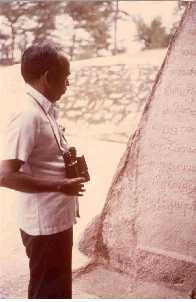
Home | Biodata | Biography | Photo Gallery | Publications | Tributes
Archaeology

 |
Home | Biodata | Biography | Photo Gallery | Publications | Tributes Archaeology |
 |
Was bowing as a method of musical sound-production known to the Pallavas 1,250 years ago? Is there any sculptural evidence to support the theory that the Pallava musicians used bowed instruments?
There is a representation of a rare musical instrument at Kanchipuram which could be the earliest representation in Tamil Nadu of a bowed instrument.
The Pallava monuments of Mamallapuram and Kanchipuram belong to the seventh and eighth centuries A.D and the sculptures on these monuments reflect the life of that period. We find in these sculptures representations of various kinds of musical instruments which would have been in actual use during that period.
The most common instrument is a stringed instrument or chordophone which was most probably called the vina in that period. King Rajasimha, the author of the shore temple and the Kailasanatha Temple at Kanchi, was called a Narada on the vina or Sri Vinanaradah. This instrument is represented more than thirty times in the Kailasanatha Temple, six times in the Arjuna's Penance panel in Mamallapuram, twice on the Dharmaraja Ratha and once on the weathered panels of the Shore Temple.
It looks quite different from the modern instrument which goes by the name of vina and does not have any fret or tuning peg. It has a long stem with a gourd attached at right angles to it. The gourd appears to be open at the bottom and the instrument is held across the chest with the gourd pressed against the chest to form a volume of resonating air.
 On the Dharmaraja Ratha there is a unique example of an ancient drone instrument also with a gourd resonator, but fitted longitudinally. Another string instrument, with a wooden body resembling a mandolin, is found on the western side of the Kailasanatha Temple outside the enclosure.
On the Dharmaraja Ratha there is a unique example of an ancient drone instrument also with a gourd resonator, but fitted longitudinally. Another string instrument, with a wooden body resembling a mandolin, is found on the western side of the Kailasanatha Temple outside the enclosure.
Thanks to the Archaeological Survey of India, the exquisite sandstone carvings of the Kailasanatha Temple are being exposed to view after the removal of thick plaster on them. There at the feet of a Harihara figure two dwarfs or ganas are revealed
![]() one with a pair of small cymbals and the other with a most unusual instrument.
one with a pair of small cymbals and the other with a most unusual instrument.
In Pallava sculptures, along with every cymbalist, either a flutist or a vina player is also depicted. Here the figure next to the cymbalist is neither a flutist nor a vina player. That figure holds a musical instrument in the form of a short cylindrical rod. It rests vertically on the cupped palm of his left hand with the upper end touching his left shoulder. In his right hand a tiny curved bow is held gently between the fourth and the fifth fingers and drawn softly across the stem. All the fingers of his right hand are kept closed. The curved bow is thinner than his fingers. The stem, itself, could have been a hollow resonator and the instrument would have been a fore-runner of the fiddle-like instruments of India.
Some scholars may hold that this is a rasp or scraper which would make an unmusical grating noise or, alternatively, just a pair of sticks struck against each other. Some others may possibly identify it as a bamboo zither struck by a small stick.
A musical instrument resembling this bowed instrument but held a little differently is found at Kazhugumalai in the Pandya country, and some scholars would identify it as a rasp called "Kirikittaka", consisting of a hollow piece of serrated bamboo and a small stick. The stick drawn across the bamboo would produce a weird grating noise.
Apart from these four kinds of stringed instruments one can see vertical drums possibly made of burnt clay. Today the Villi tribesmen of Mamallapuram get their drum-shells made by the potters of Punjeri village nearby, and stick the diaphragm to the shell with animal glue. Hour-glass-shaped drums of two kinds and a short horizontal drum are also represented in sculpture.
The flute, the conch shell, and the hand bell are the other kinds of musical instruments depicted in Pallava sculptures. By closely observing the musical instruments in sculptures one can follow the evolution of many instruments of South India over the centuries.